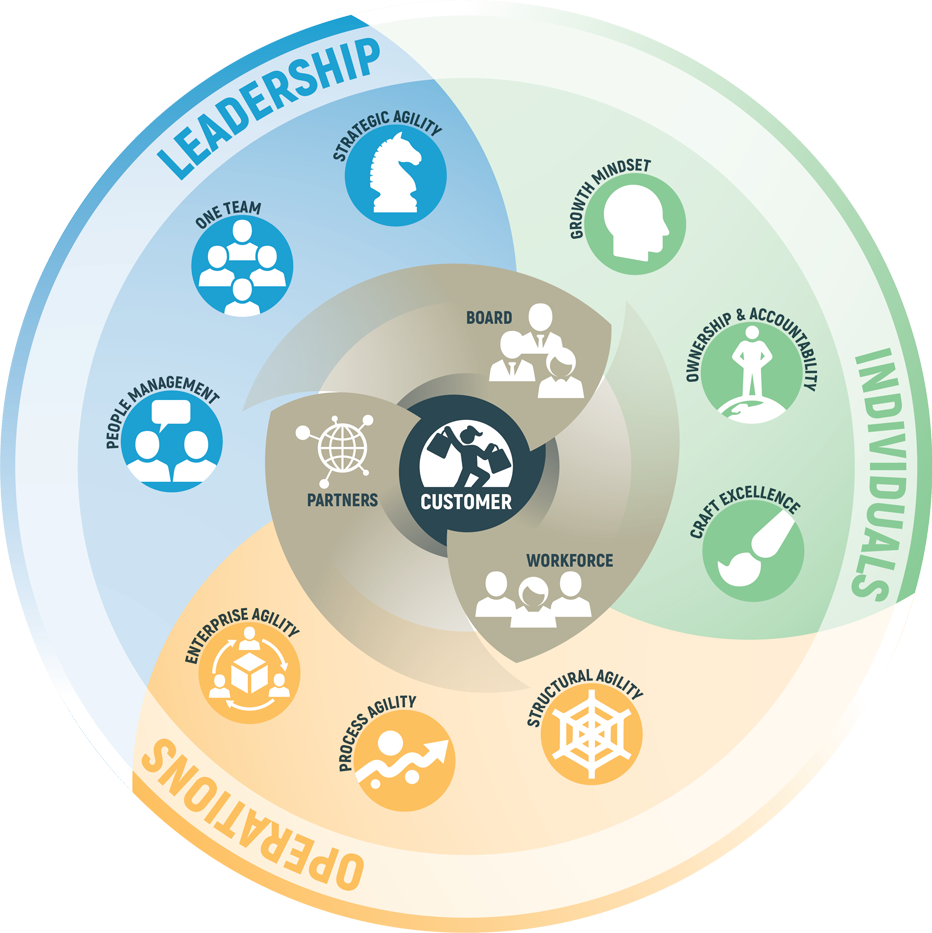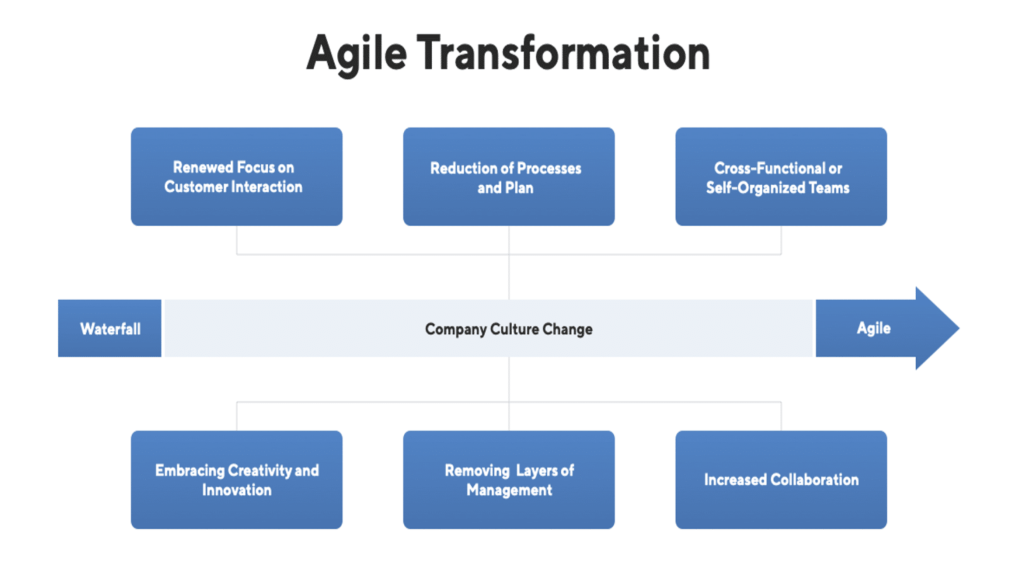“I haven’t had a lot of good experience with HR and agile. I know there are HRs that do agile well. I believe that – with or without them – the business needs to become agile. If they are great, it’s good. If they are not, try to bring them along as much as you can but don’t halt the journey.” – said a business leader in his presentation not long ago. It seems that in the future, HR leaders will not have many options in relation to the agile transformation. What does business agility mean? What are the areas of business agility? How does an HR leader contribute to the agile business transformation?

Focus, speed, and flexibility in the industrial sectors
Let’s take a simple example. In 2019, Unilever’s Foods & Refreshment department that operates in the Benelux region (its best-known brands are Magnum, Ben&Jerry’s, Hellmann’s and Knorr) decided to choose the agile approach. They made this decision to enhance the product development stage and to shorten the time-to-market of new products. They divided the employees into several groups, and via discussions between the group members, they identified the problems that needed solution. This resulted in more effective concentration and less distraction.
Let’s take a simple example. In 2019, Unilever’s Foods & Refreshment department that operates in the Benelux region (its best-known brands are Magnum, Ben&Jerry’s, Hellmann’s and Knorr) decided to adopt an agile approach. “The decision was taken in order to enhance the product development phase and shorten the time it takes to bring new products to market. They divided the employees into several groups, and via discussions between the group members, they identified the problems that needed solution. This resulted in more effective concentration and less distraction.”
At the end of 2020, almost one year after the introduction of an agile approach, the Benelux region reported 25% project capacity increase and less time-to-market. The team members indicated lower level of stress and 85% of them were satisfied with the agile methods implemented. 84% of them experienced improved focus during work, and 92% of them said that they would recommend the agile way of working to their colleagues.
The appearance of agile operation in other industrial sectors is a very good example to not only technology companies (e.g. software, telecommunication, construction, engineering, aerospace and automotive) can successfully adapt the agile approach and methods. Companies use agility mainly in environmental conditions that are fast-changing, unpredictable, highly uncertain, and very risky as well as in case of slow organisational response, increasing market pressures, products with low customer value and employees with low level of commitment.
Achieving business results
Agility is not about applying agile methodology but about achieving business results. Therefore, agility is extremely important for every company that wishes to succeed in a sustainable manner in the 21st century. Agility enables companies to respond quickly and to adapt themselves to the market environment and the constant changes (VUCA world), to satisfy the ever-changing needs and wishes of customers and employees, and it enables the individuals, teams, and companies to innovate.
In the past more than two decades, there were three agile waves that showed how our work culture has changed during the years. And at the same time these waves have challenged and are still challenging many of the old paradigms that have become entrenched in our business conduct. The first wave of agility was the Agile Team that was limited to the Leadership of technological departments, and software development was in its focus. The second wave of agility was the Agile Scaling that was not only about one or two projects but about the alignment of several teams’ work within one single agile framework. The third wave is about Business Agility. The organisations develop an agile mindset in every area of their business activity (including front and back-office functions), which improves the efficiency of the whole business.
More and more senior executives state that their company operates in an agile manner, however, many of them do not fully understand its benefits, conditions, and practice. Others consider agility to be a trend only. As Edwards Deming said: “It is not necessary to change. Survival is not mandatory.”
Business Agility
Since you are an HR Leader, Business Agility will sooner or later become an integral part of your work. Please let me contribute to the increase of your knowledge by using the Business Agility Institute model.
“Business agility is a set of organizational capabilities, behaviors, and ways of working that affords your business the freedom, flexibility, and resilience to achieve its purpose. No matter what the future brings.“
Business agility is about operation that is quick and flowing and not about adding new principles and processes to the already existing rigid work methods. Business agility questions the current state of business conduct – it tries to answer the question how people who form an organisation can be freed for the organisation to achieve its goals in terms of efficiency, added customer value and business results.
The reason I like the Business Agility Institute’s customer focused model that consists of 13 domains and 4 key areas is because it shows in a simple and comprehensible way what it means to be an agile organisation irrespective of industrial sectors, size, or context.

Source: Domains of Business Agility, Business Agility Institute
The 4 key areas are the following:
Leadership: You need leaders who make the organisation’s internal functions, teams and departments make joint efforts in order to achieve common goals, who focus on recruiting and developing the skills of those employees that fit into the company’s future potential and mission rather than into a certain position, who formulate and communicate a dynamic/adaptive strategy, and who empower the teams and individuals to respond to and create innovative solutions to business opportunities in a timely manner.
Operations: Business agility requires organisational structures, constantly adapting/improving operations and management frameworks that enable the rapid capture of new business opportunities and creation of added customer value.
Individuals: The individuals’ adaptability, creativity, openness for continuous learning and personal development, their responsibility and accountability are one of the most important basic conditions for business agility that can be accomplished exclusively in a psychologically safe and fearless leadership environment.
Relationships: Business agility requires empowered workforce that adapts to the company’s missions, external stakeholder management that focuses on customer value and an open, two-way relationship between the organisation, its leaders, and the board of directors.
And the heart of business agility is nothing but the reason why economic organisations exist: the Customers.
Every area of business agility represents a basic aspect of an agile organisation; all of them are important, needed and relate to the other areas.
The role of HR leader in the agile business transformation
As an HR leader you are key to fostering the business agility of your organisation.
Please have a look at this graph.

Source: How to make agile transitions in a company, Leadership Tribe
As an HR leader you can contribute to the agile transformation of a business in almost each and every area. The most important areas are the following:
- evangelization of agile approach
- introduction of agile culture
- creating a dynamic/adaptive strategic orientation
- making the organisational structure/processes/management framework simple and flexible
- choosing/improving the skills of the appropriate colleagues and leaders
- change management and strengthening communication
- supporting cooperation between the teams/individuals
- promoting creativity and innovation
- constant experimenting and encouraging people to study
- determining new career paths
- reviewing the incentive scheme
The benefits of business agility
„A system is more than the sum of its parts: it is an indivisible whole.” – said Russel Ackoff. Accordingly, agile teams on their own have nothing to do with business agility.
The characteristic of business agility is the agile mindset and the constant and seamless presence of agile interactions in each and every area of the organisation, which enhances the efficiency and customer focus of the company. An organisation accomplishes business agility in case it can perceive dynamically and then respond in a focussed, quick, and flexible manner to the internal and external changes in order to achieve its goals, increase its competitive advantage and ensure the survival of the company even in the most extreme situations. Today the question is not whether we should operate with agility but where and to what extent should we use agility to exploit business advantages.
Sources: Successfinder: The three waves of Agile, Rich McEachran: How to make the leap to a truly agile business, Alexander Birke: Business Agility als “bessere” Form von Agilität?


